Abstract
One important goal of the climate commitment in the European Union (EU) is to reduce primary energy demand in the transport sector and increase the use of renewables, since around 33% of primary energy is consumed in this sector. Therefore, the EU ordered its member states to raise the number of electric vehicles (EVs) within Europe. Consequently, the energy demand for electricity will rise as a function of the number of EVs. To avoid local grid overload and guarantee a higher percentage of clean energy, EV charging stations can be supported by a combined system of grid-connected photovoltaic modules and battery storage. In this paper, the focus lies on the feasibility and economic aspects of such systems. To provide an overview of the different e-charging station combinations, a support tool was modelled and developed, making it possible to size and manage EVs charging stations with only a few input parameters. Thanks to its easy handling, the tool suits a wide spectrum of users. Due to enhanced optional settings, this tool is suitable for detailed input parameters for professionals as well. Input categories are basically divided into the photovoltaic (PV) system, battery storage, the charging station itself, and investment analysis. The tool supports decisions for solar charging stations designed for different parking locations like offices, schools, and public and private places.
1. Introduction
The first electrical motorized car was developed in the middle of the 19th century by Robert Anderson. However, the issues of storing electrochemical energy hindered the spread of electric vehicles (EVs). Furthermore, almost at same time, combustion engine-vehicles (CEVs) knocked EVs out of the market. To this day, electric vehicles suffer from low energy capacity and therefore are held back from spreading in the market as desired [1]. Nevertheless, forced by international political climate targets, the involvement of EVs has become a highly ranked purpose. Stimulation of the EV market by policy instruments, especially traffic in cities, aims to reduce inner cities’ air pollution and reduction of primary energy demand. Political triggers can be price reduction for new EVs, prohibition of internal CEVs at specific areas and new registration [2]. Rome, Paris and Oslo, for example, have decided to ban diesel by 2040 [3]. In 2017, about 1 million new units were sold worldwide. Thereby, Europe, with the second-highest sale volume of EVs, bought about 280,000 vehicles, behind China, which bought half of the produced EVs in 2017 [2].
As it is not possible to charge EVs as quickly as CEVs yet, Tesla, one of the most important electric car and charging station developers, is researching intensively to find new technologies for fast charging systems. One example is the supercharger, which already makes it possible to charge Tesla’s cars to 80% capacity in below 30 min [4].
Nevertheless, this does not indicate anything about the electricity mix. Even though it is popular to combine e-stations with photovoltaics, this does not mean components work together at their optimum. Especially, when it comes to fast charging stations, more complexity in the technical aspects is required. The electricity consumption used for EVs is expected to increase from 0.03% in 2014 to 9.5% in 2050 [3]. Due to rising electrical energy demand, it will be indispensable to supply energy for EVs from local renewable energy systems. Therefore, this work deals with the feasibility and economics analysis of e-charging stations.
The incorporation of renewables into EVs charging stations has been studied in the last few years by several researchers with different approaches. In Mastny, Islam and Dai [5,6,7], a mathematical model verifies the possibilities of mutual cooperation of individual elements of the hybrid system with storage from the point of view of energy balances. Other studies [8,9,10,11] have as their main aim the sizing and optimization methodologies of EV charging stations. The environmental and economic impacts of this type of technology have also been studied by some authors [12,13,14].
Although EVs and solar charging stations are mostly considered ecologically friendly, their ecological value may differ depending on their production, operation, durability and recycling rate. However, owners of EV and solar charging stations can influence the environmental friendliness of their products in each of these steps. Influences can be reached commencing with thorough research and careful choice of products with a higher sustainability value than other comparable products. Especially regarding batteries in EVs or battery storage for solar charging stations, guidance is advised. The usage of rare earth metals in batteries, as one example, confirms the relevance of thorough choice by using batteries with alternative materials [15]. Nevertheless, the considered tool does not relate to further ecological issues but to the operation of EVs and solar charging stations. The reason for this is that users can most effectively improve the ecological value by the operation of EVs and solar charging stations.
The energy demand of EVs is addressed in [16], while the appropriate sizing of a PV panel for charging a PHEV is discussed in [17]. The impacts of EV charging on distribution power systems is a subject that has also been studied by several authors in recent years, as it will certainly influence the management of these grids. The authors of [18] address strategies for EV charging to reduce the impact on power grids. New challenges are posed with the design of PV charging stations for a car-share service. While a small photovoltaic system may not provide enough energy, a large photovoltaic system can generate wasted energy. On the other hand, solar energy is intermittent, since the amount of energy generated on a given day depends on climatic conditions. Finally, vehicles must be charged in such a way that discharged batteries have a higher priority than batteries with more charge. In [19] is an approach to apportioning solar energy to cars such that it maximizes both solar utilization and user satisfaction.
The main aim of this research is to present a model for offering a technical and economic comparison between different charging stations under different load conditions, helping the management of such systems. To achieve this goal, an effective and easy, friendly Excel®-based tool was developed. By offering various parameter inputs, the tool supports customer decision making. It is a tool that aims to help in the planning and management of EV solar charging stations and, at this stage, is only available for on-site Installation. It is the authors’ intention to develop new versions for mobile devices and web-based solutions. Beginning with the location, the user needs to choose in which country and city he/she locates the solar charging station. The weather data profile of this region is generated. Depending on if it is a private charging station or a public station at which other people can charge their cars as well, the amortization period will be affected. In case credit has been raised, interest rate and duration need to be considered for a more precise payback period. For users who are unexperienced with battery storage, photovoltaic systems, or inverters, the tool offers the possibility to calculate an optimized system based on previous user inputs. Availability and self-sufficiency are the main criteria when it comes to charging systems operating either isolated or grid connected. Due to these parameters, a comparison between different solar charging systems can be offered, with which customer decisions can be supported. The tool offers the possibility of preliminary price estimate for a system, costs and savings for charging EVs, return on investment and energy efficiency of the system.
Results show that profitability and self-sufficiency of charging stations often do not harmonize but can be balanced by optimized systems. Increases in systems’ self-sufficiency mainly lead to losses in profitability and vice versa. Hybrid charging stations are attractive with the fact that surpluses can be stored in batteries or fed back to the grid. However, oversized batteries cause economic losses. Due to the tool, economical and energetic balances or maxima shall be analyzed by the tool. Therefore, any requirements for the charging station can be supported by at least one efficiency-balanced charging station. As the tool is based on Excel®, the tool easily can be adapted and expanded optionally by implementation of further weather data, car data, relevant system components and additional energy consumers. However, at this point, the tool is limited to five cars at a maximum charging load of 22 kW each, an inverter capacity of 100 kW, and European cities only, due to common European electricity network standards.
This paper is organized as followed: Section 2 gives an overview of the methodology used in the tool development, Section 3 describes all the components belonging to the PV charging station, explaining the basis for its dimensioning, Section 4 provides an exhaustive description of the tool and its main blocks, Section 5 presents the results of the case studies, carrying out a cost/benefit analysis, and, finally, Section 6 draws the main conclusions.
2. Methodology
As the first step of the research methodology, necessary components are defined and listed. These components are photovoltaic modules, inverters, battery storage and charging station assembling, with the plugin for the EVs. Besides the technical and operational options, the developed model also assesses economic issues. To achieve this goal, it is essential to know the current electricity prices in the various European states and the trend they present for the coming years. Figure 1 shows the evolution of prices in Portugal and Germany and their respective trend lines, which will serve as a basis for technical and economic evaluation [20]. Further, the price development curve of PV system depending on installed kWp is illustrated in Figure 2, relating to current market prices for PV systems [21].
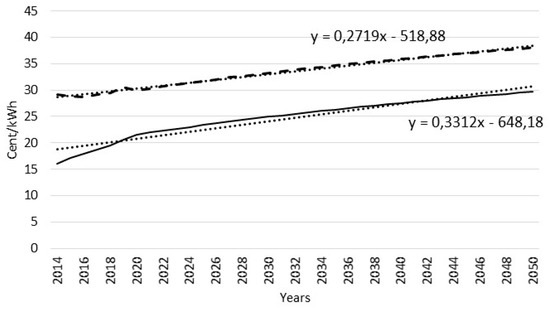
Figure 1.
Electricity price development in cents/kWh with trend lines (dashed line: Germany; continuous line: Portugal).
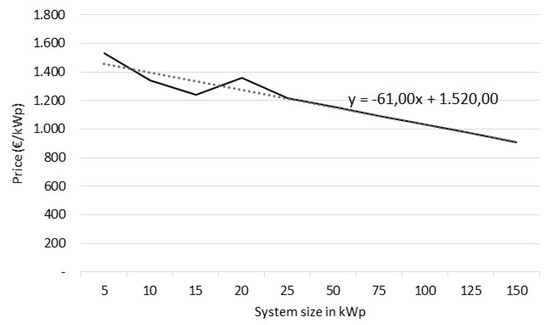
Figure 2.
Price curve (with trend line) of photovoltaic (PV) systems according to sizing.
Load profiles are taken from statistical evaluations and help to prepare a realistic simulation for public solar charging stations due to probability distribution. The tool offers the most common and most sold EVs in Europe for calculation. Therefore, car data are provided from respective companies including autonomy, energy efficiency and battery capacity and stored in a data base. Car pricings are not included into the calculation for the amortization period. Likewise, data from storage batteries, inverters and PV modules are provided by respective manufacturers and the user can choose it from a data base. However, if the user wants to choose a manufacturer on his/her own this opportunity is given as well. Therefore, data like capacity, charging and discharging rates and system performance are implemented.
The weather data used in this study come from Meteonorm®. This software helps determine averaged and hourly temperature and global irradiation over a one-year-period for sizing PV systems. Implemented weather data are recorded by real weather stations from capitals of each European state in 2018. However, the tool makes it possible to keep weather data up to date.
2.1. Load Requirement at the E-Station
This work focuses only on the most sold battery electric vehicles (BEVs) in Europe 2018 according to [22]. The sales numbers are relevant for computing the probability when the type of the charging car is not known at public charging stations, for instance. Accompanied by the efficiency and battery capacity of these cars, the corresponding energy demand to fully recharge the cars is estimated. The battery capacity of BEVs is limited to 100 kWh in this paper, and only AC charging is available due to differences in the technical structure of the systems. Figure 3 shows the relation between autonomy with a fully charged battery and the battery capacity of each car type. Both models of Tesla are equipped with 100 kWh battery capacity, supporting about 450 to 500 km of autonomy. This means an efficiency of about 4.7 and 5.3 km/kWh. Compared to more efficient EVs like Hyundai Ioniq Electric and Smart EQ (Fortwo) ED, they reach 7.1 and 9.1 km/kWh. These efficiency differences between the EVs can influence the calculation positively or negatively, especially when it comes to long driving distances in which more energy needs to be recharged.
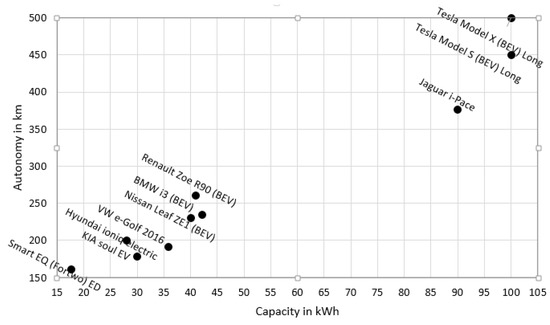
Figure 3.
Battery performances.
2.2. Charging and Driving Behavior of Customers
As this tool offers to situate the charging station at different locations, different charging behaviors of customers are expected. Charging at school, for instance, demands different charging behavior regarding charging time and charging period than charging cars at home. According to [23], it is possible to define standard behaviors and driving and charging patterns. These results may help to develop charging infrastructure location and to evaluate the electric vehicle integration into the grid. Table 1 presents some of these results that will be at the base of the model, namely, values for daily distances for business and private use. Likewise, users can add daily distances manually in the tool. As Table 1 shows that distances since last charge and daily distances are approximately the same value, this means that daily distances in most of the cases are estimated at once. Thus, the tool considers that, between two periods of charging, the daily distances will be consumed. In turn, a user selects specific charging in the tool, and driven distances will be covered between charges.

Table 1.
Travelled distances [23].
2.3. Charging and Driving Behaviour of Customer
To generate load profiles, different options are given. The user can select between charging at home, school, the office or in public stations. In case none of these pre-defined profiles fit the users’ requirements, specific charging profiles may be selected. Depending on users’ input, if profiles are constant or dynamic, the profiles are generated with non-stochastic values or stochastic values including a simultaneity factor. Thus, when the percentage of a stochastic diagram is low, the probability of charging the cars is also reduced. The graph of Figure 4 shows how the probability influences the stochastic charging profiles. Non-stochastic profiles operate only with charging all cars or charging no car. Stochastic-orientated profiles calculate each car’s charging profile individually and therefore provide up to five diversified profiles, which consequently influence total energy demand and the irregularity of load power peaks.

Figure 4.
Stochastic charging profile probabilities along a weekday.
Figure 5 shows the difference in total energy demand in both cases, non-stochastic and stochastic profiles. In both graphs, five cars are used, charging at same time but with different charging loads and capacities. In the graph of Figure 5a, all cars are charged at the same time, while the graph of Figure 5b shows a percentage of randomness in charging behavior. This random factor leads to a load transfer to a later time in the day in this case. While, in Figure 5a, all cars are fully charged at 1400. in Figure 5b, cars are still charging at 1700. Therefore, these different demands influence the solar charging station sizing regarding PV panels, inverter and local battery storage.
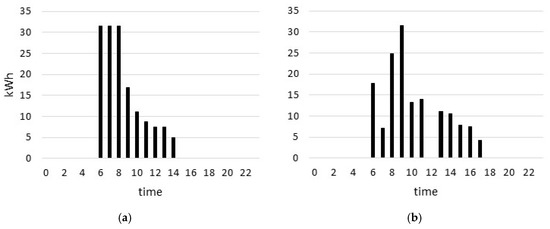
Figure 5.
Energy demand due to stochastic and non-stochastic profiles. (a) Non-stochastic generated energy demand, (b) Stochastic generated energy demand.
3. Solar Charging Station Relevant Components
This chapter contains relevant components to supply and run charging stations. Therefore, it implies performance and characteristics of the main components, including battery storage, the PV system and the inverter. It describes the theoretical calculation that is used in the tool for sizing each component, which needs to be automated as users of the tool only need to add required performance. Each performance is used for further calculation in the tool to analyze yearly production and demand and consequently provide results for self-sufficiency and efficiency. Therefore, these calculations are the basis of the developed model.
3.1. Characteristic and Performance of PV Modules
The PV cell can be approached by a current source in parallel with a diode, where the output is proportional to the incident solar radiation on the cell, as shown in Figure 6. The PV current source represents the equivalent current generated by solar radiation and the diode representing the electron exchange at a p-n junction crossing by ID current, which is dependent on its own saturation current and voltage between the PV cell terminals, given by Equation (1).
where:
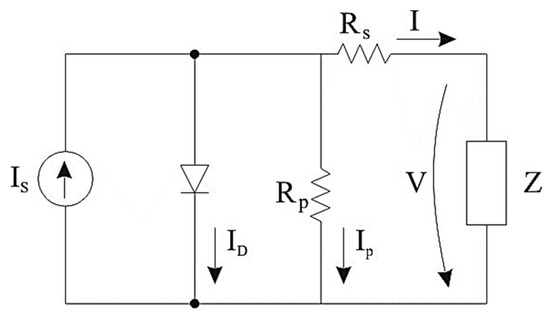
Figure 6.
Equivalent electrical circuit of a PV cell.
- m is the diode ideality factor;
- I0 is the reverse saturation current;
- VT is the thermal potential.
For better accuracy, the detailed model for the PV cell of Figure 6 must be used. This circuit includes two resistors; Rs represents the internal voltage drop and Rp represents the leakage stray currents. Applying Kirchhoff’s current law to the circuit, the load current is now by given by Equation (2) and the current through the resistance is given by Equation (3).
Substituting into Equation (2):
To better understand the behavior of photovoltaic cells, many manufacturers provide the values of VOC (open circuit voltage), ISC (short-circuit current) and Pmax (maximum power), at standard test conditions (STC) (cell temperature of 25 °C and an irradiance of 1000 W/m2). Thus, it is possible to calculate other parameters such as the ideality factor (m) and the reverse saturation current (I0) using Equation (5).
Photovoltaic cells have a limited potential since the open circuit voltage is independent of the solar cell area and is limited by the semiconductor’s properties. The maximum power of a cell does not exceed 2W, which is insufficient to supply most applications, so the cells are grouped into PV modules, which, in turn, are also grouped together, forming a PV panel [24,25]. The parameters that characterize PV modules are usually [26]:
- Constant parameters, like the ideality factor (m) given by Equation (6).
- Parameters that depend on radiation, like short-circuit current (ISC), given by Equation (7), where G represents the solar radiation.
- Parameters that depend on temperature and maximum voltage (Vmax), given by Equation (8).
Considering the use of an inverter to generate a sinusoidal waveform at the output, the energy produced by a module during a given time interval Δt can then be calculated from Equation (9).
3.2. Battery Storage
An important component of the system is the storage battery bank. The possibility to store the energy produced by a PV system for later consumption during the night or on lower radiation days is one of the great advantages. This section explains the methodology to calculate the performance of the storage battery as well as the optimal battery size to achieve the energy and financial balance. lithium-ion batteries (LIBs) are currently considered the most attractive battery system due to their comparably higher energy density, efficiency and lifetime (especially cycle life), together with their higher cost reduction potential. Lead acid batteries (LA or Pb-Batteries) have the advantage of lower investment costs but have higher mass and a lower cycle life. They are used alternatively to LIB in PV batteries for household systems. LIBs are expected to be cost-competitive compared to LAs from 2020, since the increasing demand for battery electric vehicles (BEV) is triggering mass production and consequent cost reductions [27]. In Figure 7, storage technologies are compared to each other in more detail with respect to energy content, power and typical charge/discharge times [28].
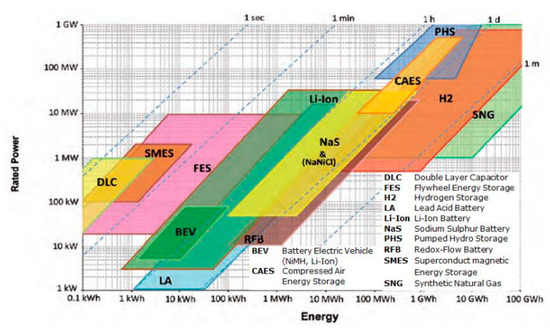
Figure 7.
Comparison of rated power, energy content and charge/discharge times for different storage technologies.
Li-ion batteries (in dark green) cover a range from 5 kW up to 12 MW, as well as lead acid batteries with a range from 1 kW to 10 MW. Both battery technologies are fit for designing individual charging stations due to their wide power range and therefore are considered in the tool. The battery capacity is obtained using Equation (10).
where:
- C—battery capacity in Wh,
- ELoad—energy demand in Wh,
- VBat—battery voltage in V,
- NAD—number of autonomous days,
- NCD—number of cycle days,
- DOD—depth of discharge in %,
- ηBat—battery efficiency.
The energy demand results from the charging power of each selected EV and the average daily energy consumption of each. The battery storage set is a table of battery storages of different performances, types, manufacturers. The number of autonomous days is multiplied to the energy demand in Ah and divided by the number of cycles that are necessary each day. Due to an expected high usage of the charging station, an NCD of one is used. This tool only offers lead acid and lithium ion batteries. Thus, in dependence on the selected battery, DODs are represented according to the manufacturer’s data sheet and battery efficiencies between 85–93% are expected. The use of PV systems with storage allows a large part of the energy produced to be consumed locally, resulting in a reduction in the associated expenses with electricity consumption. In the design of a PV system, there are some parameters that it is important to evaluate, such as the amount of self-consumption and the degree of self-sufficiency. The amount of self-consumption indicates the quantity of the PV energy generated that is consumed on site. Photovoltaic energy can be directly consumed by the loads at the same time or used to charge the battery. The so-called degree of self-sufficiency describes the amount of electricity demand that is simultaneously supplied by the PV storage system. Both evaluation variables are influenced by the battery storage and the size of the PV system. The Quaschning’s diagrams [29] presented in Figure 8 show that, already, 30% of both self-consumption and sufficiency are covered, when 1 kWp of PV per MWh of consumed energy is installed. Battery storage additionally raises the percentages of both self-consumption and sufficiency and is represented in the y-axis. By raising 1 kWh of battery capacity per MWh of energy consumption, self-consumption and sufficiency ratios improve to approximately 60% and 50%. Raising the PV output disproportionately compared to the battery capacity will consequently reduce the self-consumption ratio of the system. For increasing the sufficiency ratio, Figure 8b shows that a balanced combination of PV output and battery storage obtain the highest sufficiency. These diagrams serve as a basis for modelling an automated system in case the user requests automated optimal calculation of the PV system.
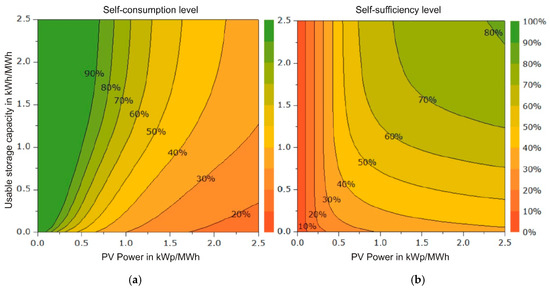
Figure 8.
Impacts of a PV system with additional battery storage (a) on self-consumption and (b) on self-sufficiency.
3.3. Mounting System
Although mounting systems for the PV modules can be realized on the roof of buildings or as building-integrated PV (BIPV), the developed tool only calculates mounting systems which are produced as carports. This system can be used for car parks or at home and is adaptable to each available size. Considering Austrian standards, a parking space is quantified with 2.5 × 5 m2 (OIB- guidelines); thus, a charging station is covered at least with a PV area of 12.5 m2 for one EV. Figure 9 shows an example of a possible carport.
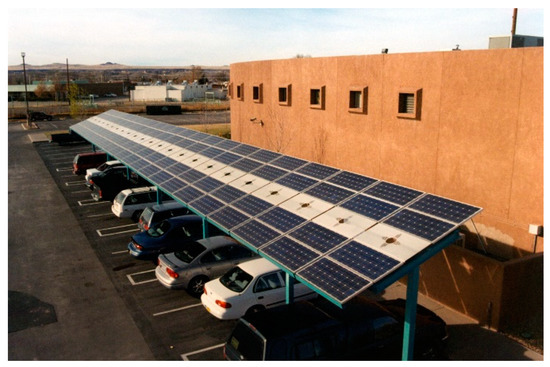
Figure 9.
Example of a PV charging carport [30].
The tool differs between grid-connected and stand-alone operating charging stations. In the case of stand-alone stations, costs for grid connection are not included in the calculations. Otherwise, the necessary power to supply the station is considered and calculated by the sum of charging power of each EV. The maximum charging power is limited to 138 kW. When greater charging power is required or additional EVs are connected, the grid connection must be reviewed. This calculation excludes the cost of installing an additional transformer or cable extension, and includes only connection costs, which are charged by the electricity provider. According to the electricity provider (SWM 2019) from Munich, prices for grid connection range from 1600 € to 4400 € (Table 2).

Table 2.
Cost for grid connection.
4. Tool Description
The tool contains previously described parameters programmed in MS Excel®. Therefore, except for the weather data, which is based on Meteonorm® profiles, all included profiles are generated in the tool itself. The tool is created for supporting users’ decisions about energetically and financially balanced solar charging stations, balancing self-sufficiency and self-consumption ratios as well as recommending the power peak of the photovoltaic system and local battery capacity. By completing user’s input once, results are updated after each further change, so the user can see the impact of the change directly. Results consist of the final report, which contains input parameters and results, and offers a handy opportunity to compare solar charging station designs to each other. The flowchart of Figure 10 shows user input processing steps, helping to clarify the methodology used in the tool structure.
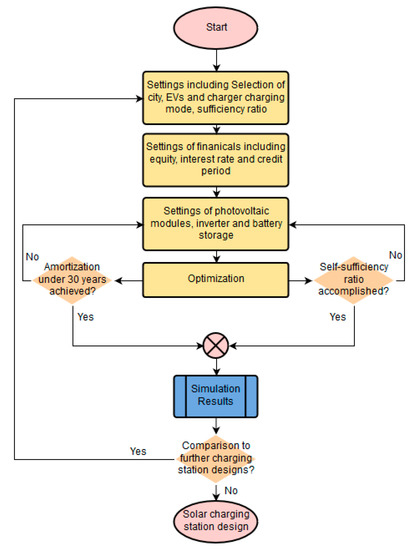
Figure 10.
Methodological flowchart of the tool.
The user interface shown in Figure 11 gives insight into the described tool input sheet, which is described in the text below.
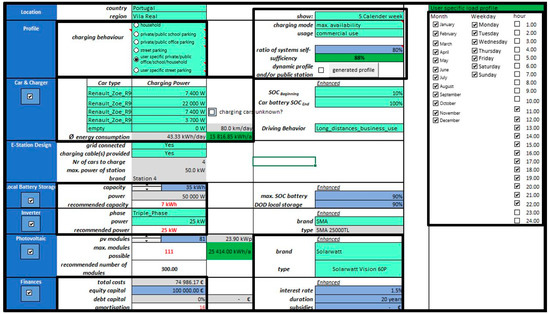
Figure 11.
User interface.
Basic Settings: Firstly, via a drop-down menu, the country and region are chosen, which affects solar irradiation, temperature, and, also, the pricing for selling or buying electricity to/from the grid.
As a next step, the profile needs to be determined. The profiles are divided into six profile types. As this tool is provided for any customer that is interested in designing an individual charging station, different charging behaviors and localizations are considered. Both parameters affect energy demand and charging schedule and, consequently, influence the ratio of self-consumption and amortization. Profiles differ between private and public. As public stations might allow any battery electric vehicle (BEV) driver to charge his/her car randomly at the station, a probability from Corchero’s survey [23] is taken into account. The probability values are conditional on time and selected profile. Private profiles are simplified and standardized profiles that lean on charging behavior surveys which do not use probability calculation. For example, the household profile is considered as private, while street parking is public. Additionally, a new profile for public stations should be generated by using the button generate profile. Profile 5 and 6 are specific profiles, which means they can be customized by the user. Use-specific profiles might be used when standardized profiles do not meet the user’s requirements for the station. In the following text, detailed descriptions of each profile are listed.
Household: The household profile considers a standardized profile of a working person that leaves home—and, consequently, the charging station—at 7 a.m. and arrives at home at 5 p.m. At this time, the car is not connected to any other station and is consuming energy. Workdays and weekends are taken into account.
Private/Public School Parking: In case of a private station at school, a standardized profile of a person that starts charging at 7 a.m. and leaves at 5 p.m. is considered. At this time, the car is connected to the school’s charging station and is contrary to the household profile. Workdays and weekends as well as summer and winter holidays are taken into account.
Private/Public Office Parking: In case of a private station at the office a standardized profile of a person that starts charging at 7 a.m. and leaves at 5 p.m. is considered. At this time, the car is connected to the office’s charging station contrary to the household profile. Workdays and weekends are considered.
Street Parking: As street parking is public and available at any time, a probability-based profile is necessary to provide a realistic calculation. Otherwise, the tool calculates permanently parking cars, which implies that cars are never in use and consume energy.
User-Specific Household/School/Office: In case the upper profile’s availability needs to be adapted, user-specific profiles enable time regulation. Profile 5 can be used for households, schools and offices.
User-Specific Street Parking: In case the charging station at street parking needs an adaption of its accessibility, this profile might be used. As an additional drop-down feature, the user must clarify if the station is for commercial or non-commercial use, which affects the amortization. The energy can be sold in form of renting the parking lot, for instance, or in any different way. Nevertheless, legislation for selling electricity or leasing parking lots is not considered further in this tool. Another important feature is the selection of the charging mode. The user can choose between three different charging modes, which affects the peak load and the ratio of self-consumption.
Maximum Availability: This mode provides the maximal charging level for the car and, therefore, provides the maximal availability of electricity. This mode might suffer lower self-consumption, for instance.
Energy Performance: This mode provides charging levels depending on the solar energy from photovoltaics or storage. The lower the solar inputs, the lower the charging level is. However, in case of low car battery, a higher charging level is used to avoid cars running out of battery. This mode increases the self-consumption and lowers impacts on the grid but also increases charging times.
PV Performance: Likewise, this mode provides charging levels depending on the solar energy from photovoltaics or storage but with even more stringent target values. This mode provides the highest self-consumption. However, it might cause a lack of energy when high demand peaks are needed. Occasionally, performance parameters need to be adjusted.
In the next field, the cars which will be charged are clarified via drop-down menu. As mentioned, the top ten most sold cars of 2018 in Europe are available. Each car may offer different charging levels, which are available in the drop-down menu next to the cars dropdown. The sum of all load powers reveals the power of the charging station and serves as a guide for the dimensions of the photovoltaic system. For local battery storage, the user needs to set the amount of capacity. The power of the battery storage results from the sum of cars’ charging power and determines the price of the station. The discharging and charging power of the station are set as equal.
Photovoltaics and Inverter: Basic settings for the photovoltaics consist of the input cell in addition to the number of photovoltaic modules. On the right side of the input field, the resulting power peak is displayed. Below this input field, guidance offers the maximal possible number of modules and the recommended number of modules. In case the maximal possible number of modules is exceeded, another inverter needs to be chosen that allows a higher number of modules. The maximal possible number is determined by the settings of the inverter, while the recommendation is calculated by the ratio of self-sufficiency of the system, which is set at profile. The performance of the inverter is set by the user and specifies the maximal number of photovoltaic modules. In case the inverter is oversized, this may lead to a drop in efficiency. Therefore, a recommendation of inverter performance is given.
Finances: After the system has been dimensioned, equity capital needs to be clarified. Resulting from the difference between system investment costs and equity capital, ratio and debt capital are calculated and shown in the grey boxes below.
Enhanced Settings: Enhanced settings are found on the right side of basic settings, only when the checkbox for this specification is activated. Enhanced settings are available for cars and chargers, local battery storage, photovoltaics and the inverter. Enhanced settings are activated and made visible by clicking the checkbox of any category.
More detailed car and charger settings include the status of the battery at the beginning and end (SOCBegin and SOCEnd), which can be parameterized. This provides information about both the status of the cars’ battery at the time it starts charging and when to stop the charging process. The reason for parameterizing the SOC is to enable the possibility of dimensioning smaller photovoltaic systems. Less energy demand for charging is needed when lower maximal SOC of a car battery is set. Consequently, this is an effective way to increase self-consumption. Another enhanced step is to clarify the driving behavior. In case the car must cover long distances, it must be ensured that those cars do not run out of battery. Therefore, a higher SOCEnd is preferred. Generally, the drop-down menu for driving behavior offers five different options. Values for different distances are taken from [23].
Short_distances_private_use and short_distances_business_use: Both options are calculated with surveyed values: 34.3 and 29.3 km.
Long_distances_private_use and long_distances_business_use: Both options are calculated with a surveyed value: 80 km in both cases.
Add driven_distances_per_day: This option is given in case the customer wants to add his/her personal driven distances. Therefore, the highlighted field need to be filled out by the driven distance. Distances longer than 200 km may cause problems, as cars may run out of battery. They need to be refilled at another place than the designed charging station and, consequently, distort the results from the tool.
Thus, this tool considers the designed station as the only charging station for set cars. Local storage depth of discharge (DOD) as well as a maximum SOC of a battery can be parameterized at the enhanced settings, in case the DOD and SOC of the car are known. Enhanced settings for photovoltaics make it possible to choose the brand and model of photovoltaic modules and influence the pricing and energy gains. The last enhanced parameters are found in the financial category where interesting rate and duration can be set.
To sum up the key sectors of the tool, a mind map gives an overview in Figure 12.
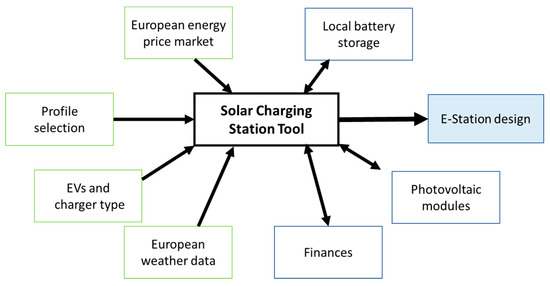
Figure 12.
Mind map of solar charging station tool.
5. Case Studies
To analyze the behavior and reliability of the developed model regarding the energy management of EV charging stations, some simulations were carried out and are described below. A simulated solar charging station has been analyzed at a workplace, in the library parking area of the University of Trás-os-Montes and Alto Douro in Vila Real, located in the north of Portugal. Results include cost estimation and amortization of the charging station with high self-sufficiency and self-consumption. Therefore, the station shall support five electric cars using at least 80% of self-produced PV solar energy over the whole year. For clearer comparison, all five cars are of the same model, equipped with a battery of 40 kWh and charging load of 6.6 kW each. Starting parameters include battery storage of 20 kWh and a 32.75 kWp PV system. Visitor time is constant over the year and adheres to opening times of the university campus, which is open from 8.00 a.m. to 8.00 p.m. from Monday to Saturday and closed on Sunday. Different scenarios are considered, as different possibilities of operation and consequently different effectivities shall be compared and discussed. These scenarios include the amount of energy that needs to be charged and amortization of the system, depending on the following:
- Operation type;
- Driving and charging behavior;
- Grid-connected or stand-alone operating solar charging station.
5.1. Operation Type of the Charging Station
As a first step of designing a solar charging station, the operation type must be clarified. In case a high availability of the charging station is necessary, the operation mode for maximal availability can be selected. This includes charging the car as soon as cars are plugged into the charging station using the highest cable- and car-supported charging load. Depending on the time of day, this operational mode can lead to increased charging at PV-off times. One example for the necessity for high energy availability is at taxi stops. However, as this station is designed for students and personnel at a university, the operation mode for increased PV performance can be selected as there is no necessity for the highest supply reliability. This mode provides energy to EVs depending on current PV output, considering a minimum load peak for cars to not run out of energy. Thus, load peaks can be reduced when sun irradiation cannot provide the load power and increase the self-sufficiency of the system. Car owners usually fill their electric cars outside their workplaces, which justifies the selection of the PV performing operation mode in this situation. Figure 13 shows the impact of both max availability and PV performing operation mode on the charging load peaks. The red line illustrates the charging load peak in the morning at 8.00 am with 28 kW (Figure 13a), supplied by a battery discharge capacity of 16 kW (yellow framed green area) and a grid load of 12 kW (black framed grey area). The status of the battery is shown in percent in yellow and the recharging of the battery is shown in blue. The green bell-shaped curve illustrates the sun irradiation on this day. It can be seen that the charging process takes place before energy from sun supports the charge. To improve supply from PV output, the PV performed operation mode helps to extend the charging process by reducing the load peak to 16 kW (3.2 kW × 5). As all five cars start their charging process at the same time, there is not enough battery capacity to bridge the morning hours of low sun irradiation, and grid energy is still needed to support the system. Further improvement measures are recommended.
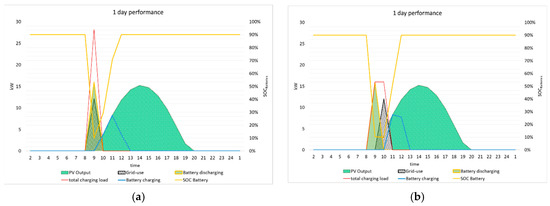
Figure 13.
One-day energy performance. (a) According to max available power load, (b) according to PV performed charging mode.
5.2. Driving and Charging Behavior
As a further step of improvement, dynamical charging profiles are used, imitating electric car owners coming to and leaving the parking area during the daytime. This measure improves the simulation of the charging station at the site as it includes stochastic probabilities of charging times. Figure 14 shows results from profiles according to Figure 4. The impacts of using stochastic or non-stochastic charging profiles can be seen in Figure 14. Pre-made, non-stochastic profiles consider cars being plugged into the station from 8.00 a.m. to 8.00 p.m. and occupying the charging point for the entire day (Figure 14a). Due to the probability of users having shorter intervals of presence than are simulated in Figure 14a, the charging profile is more likely to be shaped as in Figure 11, where three charging load peaks happen during the day, at 10.00 a.m., 2.00 p.m. and 6.00 to 7.00 p.m. This leads to a further reduction of the morning peak to 9.6 kW but causes a reduced SOC of the local battery storage due to the evening charging peak. Nevertheless, morning grid load peaks can be reduced or even avoided.
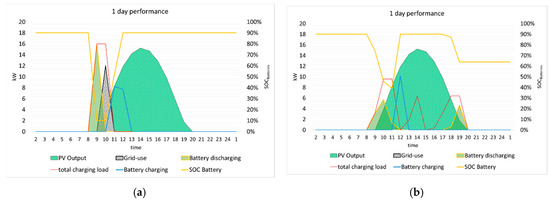
Figure 14.
One-day energy performance: (a) according to non-stochastic charging profiles and (b) according to stochastic charging profiles.
Results are shown in Figure 14a, where local battery storage can be fully charged during the day and surplus energy from the PV system feeds the grid. Surplus energy is fed to the grid. Due to battery capacity, less support from and feeding to the grid are necessary and, therefore, higher self-sufficiency of the system is expected. Nevertheless, a negative impact on the amortization of the system is expected. To sum up recent results, a reduction of load peaks, especially in the morning hours, helps to bypass a shortage of self-produced energy. This can be achieved by setting a load power limit depending on PV output.
Moreover, the driving behavior of electric car owners who make use of the charging station impacts the energy performance of the system. Independently of EVs’ battery capacity, daily driven distances range between 34 km and 80 km for private or business use [23]. For the charging station located in Vila Real, a low driven distance of 34 km/day is selected in prior scenarios. Considering a new scenario, where the distance covered is increased to 80 km, it can be compared to Figure 15. Results show a higher discharge of the local battery. In the evening hours, the grid supports the charging station additionally, as battery energy capacity does not cover the daily car energy demand of 57 kWh. A lower self-sufficiency of the system is expected.
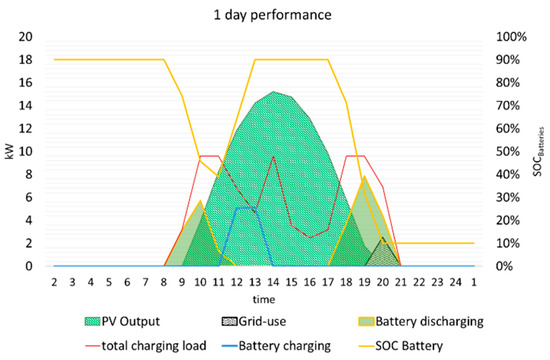
Figure 15.
One-day energy performance of the charging station when driven distance is increased to 80 km/day.
5.3. Grid-Connected and Stand-Alone Operating PV Solar Charging Systems
For grid-connected charging stations, power for EVs can always be provided from the grid, whereas a lack of energy supply in the off-grid mode must be considered and evaluated. The graphs in Figure 16a show the energy balance of one-day performance, and Figure 16b shows the availability of the charging station in an energy balance diagram. The outer circle of the energy balance represents the self-consumption of the system by comparing energy production, storage and losses in percentages. The inner circle shows the self-sufficiency of the system, as well as the lack of energy supply. In case of energy shortage, cars with higher storage status are supplied with less energy or will even not be supplied, to ensure energy for cars with low storage status. Depending on the relevance of the charging station’s energy support, a lack of energy supply must be considered. Charging stations with necessary high availability should be designed with no lack of energy, whereas a charging station located at a workplace does not need to provide 100% of energy to its EVs, as private EVs are most likely charged at private charging stations additionally. Figure 16 shows a one-day performance system considering 32.75 kWp PV modules and 20 kWh local battery storage, with 80 km of daily driven distances.
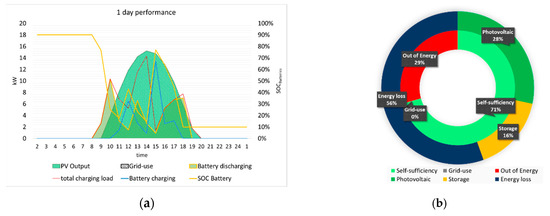
Figure 16.
One-day performance according to a stand-alone operating charging system. (a) power management, (b) energy balance.
The local battery profiles show that the PV system cannot provide the requested energy demand without local battery storage running empty. The red area in Figure 16b shows that 29% of necessary energy to supply cars cannot be supplied. Therefore, the self-sufficiency of the system is theoretically reduced to 71%. Moreover, the blue area represents the system’s energy loss of 56%, through PV surplus that cannot be supplied to cars as well or to the fully charged battery’s storage immediately. Loss of energy can be used for additional consumers like households. However, EVs are considered the only consumers in this model. In Figure 17, the self-sufficiency of the isolated operating charging station is improved by reducing driven distances back to 34 km, which represents average distances to workplaces (Figure 17a). Furthermore, an adaption of the PV system is executed to improve energy balance by reducing energy losses (Figure 17b).

Figure 17.
Energy balance for driven distances of 34 km/day: (a) off-grid charging station; (b) off-grid charging station with reduced energy losses.
Results show that, with reduced daily driven distances, a full energy support, thus 100% self-sufficiency, is expected. However, energy losses rise to 71%, which indicates oversizing of the charging station’s PV system or battery storage (Figure 17a). A reduction can be achieved by reducing the PV system to 21 kWp, with same amount of battery storage, 20 kWh (Figure 17b). Due to lower consumption of EVs, an energy loss of at least 61% is expected. Furthermore, it is expected that the system will run out of energy at 15% due to a reduction in the PV power peak. Impacts on the amortization of each variation of charging station are described in next section.
5.4. Energy Balance and Amortization
After designing and sizing different EV charging stations based on their energy balances, a further important step is to economically evaluate investments, particularly with regard to amortization periods (payback). The economic analysis carried out took into account the four scenarios previously described:
- Grid-connected, 20 kWh battery storage, 32.75 kWp, 34 km daily driven distances;
- Grid-connected, 45 kWh battery storage, 32.75 kWp, 80 km daily driven distances;
- Off-grid, 20 kWh battery storage, 21 kWp, 34 km daily driven distances;
- Off-grid, 20 kWh battery storage, 32.75 kWp, 80 km daily driven distances.
Each scenario is calculated with the same dynamical charging profile and same car types (including battery capacity and load peak), as well as with a self-investing sum of 100,000 €. At each scenario, energy is sold to cars for 0.24 €/kWh. Grid-connected charging stations additionally sell their surplus energy to the grid for 0.10 €/kWh. Energy from the grid is bought for 0.22 €/kWh, based on the electricity price development shown in Figure 1. All graphs consider a period of 30 years of operation, with a reinvestment after 20 years due to maintenance. Additionally, the amortization calculation considers yearly maintenance of the station’s components, inflation and estimated pricing curves of the next 30 years. Curves start at initial investment and therefore show negative results. When crossing the zero line before 30 years, the charging station is considered economically viable. The break-even point also represents the period of system amortization.
Considering the grid-connected systems, Figure 18 and Figure 19 show that, in both cases, amortization is likely to happen after around 15 to 25 years. Due to reinvestment after 20 years in the second scenario, the curve passes the zero line twice, firstly after about 17 years and secondly after 25 years. Results show that the amortization curve of the second scenario, with higher daily distances of charging cars, is steeper, due to higher energy consumption and consequently more energy purchases. In the first scenario, more energy must be sold to the grid instead of to cars and this therefore flattens the amortization curve relative to the second scenario. As the second scenario does not reach the target value of 80% self-sufficiency when using 20 kWh battery storage, the storage is increased to 45 kWh. Therefore, the amortization period is expected to be 25 years.
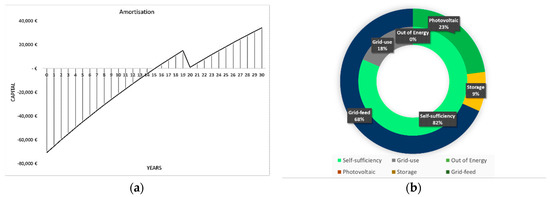
Figure 18.
Grid-connected, 20 kWh battery storage, 32.75 kWp, 34 km daily driven distances: (a) lifetime payback graph, (b) energy balance.
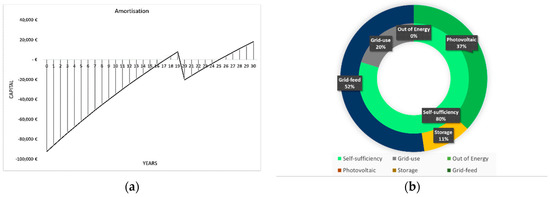
Figure 19.
Grid-connected, 45 kWh battery storage, 32.75 kWp, 80 km daily driven distances: (a) lifetime payback graph, (b) energy balance.
Next, the analysis is shown for off-grid systems. Figure 20 shows that an off-grid station that is designed for electric cars with a driven distance of 34 km per day struggles with economic efficiency. A reduction of PV modules reduces investment costs but flattens the amortization curve at the same time. The amount of energy sold to cars is not enough to amortize over 30 years. Due to the higher consumption shown in Figure 21, amortization after 28 years is estimated, but, at the same time, a lack of energy of 29% is expected. Therefore, the charging station is rated as not highly reliable. An increase in battery storage leads to a lower lack of energy but reduces amortization. Nevertheless, in both cases, a high energy loss is calculated, which can be used for further consumers like households, etc. This measure would increase the amortization of both scenarios significantly. Another possibility to improve amortization is an increase in energy price at the expense of customer satisfaction. To reach amortization within 30 years, the energy price must be at least 0.35 €/kWh.
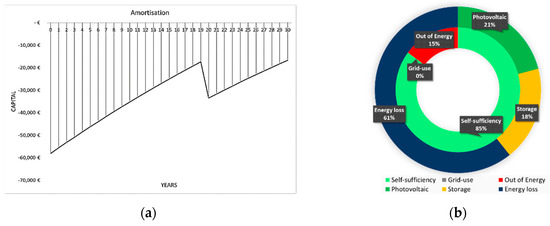
Figure 20.
Off-grid, 20 kWh battery storage, 21 kWp, 34 km daily driven distances: (a) lifetime payback graph, (b) energy balance.
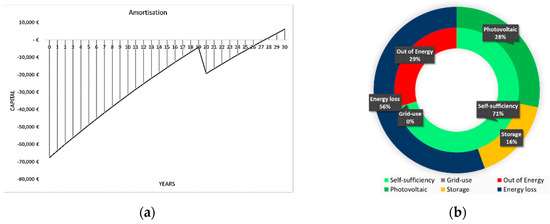
Figure 21.
Off-grid, 20 kWh battery storage, 32.75 kWp, 80 km daily driven distances: (a) lifetime payback graph, (b) energy balance.
6. Conclusions
Results of the analysis show that a charging station based on renewable energy sources constitutes an efficient alternative to a conventional charging station based on grid usage. By the usage of renewable energies, not only a reduction of CO2 emissions is ensured but also a reduction in power grid usage. Especially regarding electric vehicles which may cause grid overload, charging stations preventing negative grid impact must be focused on. Trendlines show the interest in increased charging power for charging spots to shorten the charging times of EVs. Currently, so-called high-power charging spots already reach up to 350 kW and enable charging times comparable to CEVs. Such projects capture attention, although their breakthrough may endanger the current grid. This trend of charging EVs with more than 22 kW makes designing and planning charging stations even more essential to prevent grid impacts. Therefore, the tool also illustratively proves that charging EVs above 22 kW is not necessary, especially as the behavior of charging EVs is changed significantly compared to CEVs.
The tool has been developed to help find solutions for each combination of charging station properties, for up to five cars, with customized proportions of renewable energies, identifying the most efficient combination. It emerges that solar charging stations for private and commercial use can be designed efficiently, although they have higher investment costs than conventional ones. Taking into account that isolated charging stations do not utilize 50% of their yield, additional consumers can reduce the period of amortization significantly. Further, results show that reduced consumption consequently flattens the amortization curve. Thus, stations should be located with high accessibility, at places with a potentially high number of electric cars or at locations with regular consumers like offices or schools. In case the charging station is located in a less trafficked area, this must be taken into account when designing the charging station, influencing the probability of charging behavior as well as the frequency of charges during a day. The less charges by electric cars are expected, the more energy will be provided to other users besides users of electric cars. Results show that a balance of energy production through PV, local storage, and usage of the grid (as well as feeding back to the grid) offer a charging station with an amortization within 22 years. A reduction in self-sufficiency consequently means a lower investment cost but does not necessarily correlate to earlier amortization of the solar charging system, which can be seen in the tool. Meanwhile, the amortization in energetical aspects correlates to sun irradiation, sun hours per year and local energy prices. Moreover, systems that rely on battery storage to provide maximum self-sufficiency typically suffer from inefficiency due to high investment and maintenance costs. Average households with electric cars can only charge their cars in the evening when arriving home from work. At the expanse of either self-sufficiency or inefficiency, customers must weigh their own interests. Furthermore, in this case, the tool can support decisions, by balancing both the sufficiency and efficiency of the charging station.
To sum up, due to the tool’s easy manageability and simplicity compared to alternative calculation software, the tool is adjusted to suit to a wide spectrum of target groups, including experts and non-experts. However, all essential parameters for designing a solar charging station are considered. Results are comparable, to further solar charging design, self-sufficiency and self-consumption ratios, and payback period. Nevertheless, the results of the tool cannot be considered reliable final values but estimations of data-based equations, as the tool simulates an operation duration of 30 years. Thus, the prediction of future market prices of system-relevant components and energy price development over the next 30 years is imprecise and puts the tool in the position of a promising decision-supporting tool.
Author Contributions
Conceptualization, S.S., J.B.; Methodology, S.S., J.B.; Software, S.S.; Performed experiments, S.S.; Data validation, S.S., J.B.; Writing—original draft, reviewing and editing, S.S., J.B. All authors have read and agreed to the published version of the manuscript.
Funding
This research received no external funding.
Conflicts of Interest
The authors declare no conflict of interest.
References
- Lang, T. 130 Years of Electric Cars: Short Bloom, Long Flop. Category News. 10 August 2012. Available online: https://web.archive.org/web/20130613062747/http:/auto-presse.de/autonews.php?newsid=137630 (accessed on 10 April 2020).
- Bunsen, T.; Cazzola, P.; Gorner, M.; Paoli, L.; Scheffer, S.; Tattini, J.; Jacob, T. Global EV Outlook 2018. Towards Cross-Modal Electrification; International Energy Agency IEA: Paris, France, 2018. [Google Scholar]
- Schmela, M. Global Market Outlook. For Solar Power/2018–2022. SolarPower Europe. 2018. Available online: https://www.solarpowereurope.org/global-market-outlook-2018–2022/ (accessed on 5 June 2020).
- Tesla. Available online: https://www.tesla.com/en_EU/supercharger (accessed on 10 April 2020).
- Mastny, P.; Moravek, J.; Vojtek, M.; Drapela, J. Hybrid photovoltaic systems with accumulation—Support for electric vehicle charging. Energies 2017, 10, 834. [Google Scholar] [CrossRef]
- Islam, S.; Mithulananthan, N.; Bhumkittipich, K.; Sode-Yome, A. EV charging station design with PV and energy storage using energy balance analysis. In Proceedings of the 2015 IEEE Innovative Smart Grid Technologies-Asia (ISGT ASIA), Bangkok, Thailand, 3–6 November 2015; pp. 1–5. [Google Scholar]
- Dai, Q.; Liu, J.; Wei, Q. Optimal photovoltaic/battery energy storage/electric vehicle charging station design based on multi-agent particle swarm optimization algorithm. Sustainability 2019, 11, 1973. [Google Scholar] [CrossRef]
- Liu, Z.; Wen, F.; Ledwich, G. Optimal planning of electric-vehicle charging stations in distribution systems. IEEE Trans. Power Deliv. 2012, 28, 102–110. [Google Scholar] [CrossRef]
- Mouli, G.R.C.; Bauer, P.; Zeman, M. System design for a solar powered electric vehicle charging station for workplaces. Appl. Energy 2016, 168, 434–443. [Google Scholar] [CrossRef]
- Choe, G.-Y.; Kim, J.-S.; Lee, B.-K.; Won, C.-Y.; Lee, T.-W. A Bi-directional battery charger for electric vehicles using photovoltaic PCS systems. In Proceedings of the 2010 IEEE Vehicle Power and Propulsion Conference, Lille, France, 1–3 September 2010; pp. 1–6. [Google Scholar]
- Gjelaj, M.; Træholt, C.; Hashemi, S.; Andersen, P.B. Optimal design of DC fast-charging stations for EVs in low voltage grids. In Proceedings of the 2017 IEEE Transportation Electrification Conference and Expo (ITEC), Chicago, IL, USA, 22–24 June 2017; pp. 684–689. [Google Scholar]
- Tulpule, P.J.; Marano, V.; Yurkovich, S.; Rizzoni, G. Economic and environmental impacts of a PV powered workplace parking garage charging station. Appl. Energy 2013, 108, 323–332. [Google Scholar] [CrossRef]
- Tulpule, P.; Marano, V.; Yurkovich, S.; Rizzoni, G. Energy economic analysis of PV based charging station at workplace parking garage. IEEE Energy Tech. 2011, 1–6. [Google Scholar] [CrossRef]
- Nunes, P.; Figueiredo, R.; Brito, M. The use of parking lots to solar-charge electric vehicles. Renew. Sustain. Energy Rev. 2016, 66, 679–693. [Google Scholar] [CrossRef]
- Ellsmoor, J. Are Electric Vehicles Really Better For The Environment? Forbes. 2019. Available online: https://www.forbes.com/sites/jamesellsmoor/2019/05/20/are-electric-vehicles-really-better-for-the-environment/#48964f2476d2 (accessed on 31 May 2020).
- Denholm, P.; Kuss, M.; Margolis, R.M. Co-benefits of large scale plug-in hybrid electric vehicle and solar PV deployment. J. Power Sources 2013, 236, 350–356. [Google Scholar] [CrossRef]
- Li, X.; Lopes, L.A.C.; Williamson, S.S. On the suitability of plug-in hybrid electric vehicle (PHEV) charging infrastructures based on wind and solar energy. 2009 IEEE Power Energy Soc. Gen. Meet. 2009, 1–8. [Google Scholar] [CrossRef]
- Wen, C.-K.; Chen, J.-C.; Teng, J.-H.; Ting, P. Decentralized plug-in electric vehicle charging selection algorithm in power systems. IEEE Trans. Smart Grid 2012, 3, 1779–1789. [Google Scholar] [CrossRef]
- Lee, S.; Iyengar, S.; Irwin, D.; Shenoy, P. Shared solar-powered EV charging stations: Feasibility and benefits. In Proceedings of the 2016 Seventh International Green and Sustainable Computing Conference (IGSC), Hangzhou, China, 7–9 November 2016; pp. 1–8. [Google Scholar]
- Heidjann, J. Electricity Prices in Germany. Available online: https://www.stromauskunft.de/strompreise (accessed on 13 April 2020).
- Märtel, C. The Cost of a Photovoltaic System. Available online: https://www.solaranlagen-portal.com/photovoltaik/kosten (accessed on 13 April 2020).
- Pontes, J. Huge Tesla High Tide in Europe. 2019. Available online: http://ev-sales.blogspot.com/2019/01/europe-december-2018.html (accessed on 10 April 2020).
- Corchero, C.; Villafranca, S.G.; Sanmarti, M. European electric vehicle fleet: Driving and charging data analysis. In Proceedings of the 2014 IEEE International Electric Vehicle Conference (IEVC), Florence, Italy, 17–19 December 2014; pp. 1–6. [Google Scholar]
- Bhaskar, M.; Vidya, B.; Madhumitha, R.; Priyadharcini, S.; Jayanthi, K.; Malarkodi, G. A simple pv array modeling using matlab. In Proceedings of the Emerging Trends in Electrical and Computer Technology (ICETECT), 2011 International Conference, Nagercoil, India, 23–24 March 2011; pp. 122–126. [Google Scholar]
- Sera, D.; Teodorescu, R.; Rodriguez, P. PV panel model based on datasheet values. In Proceedings of the 2007 IEEE International Symposium on Industrial Electronics, Lisbon, Portugal, 4–6 July 2007; pp. 2392–2396. [Google Scholar]
- So, J.H.; Yu, B.G.; Hwang, H.M.; Yoo, J.S.; Yu, G.J. Comparison results of measured and simulated performance of pv module. In Proceedings of the Photovoltaic Specialists Conference (PVSC) 34th IEEE, Philadelphia, PA, USA, 7–12 June 2009; pp. 22–25. [Google Scholar]
- Steen, M.; Lebedeva, N.; Persio, F.; Boon-Brett, L. EU Competitiveness in Advanced Li-Ion Batteries for E-Mobility and Stationary Storage Applications—Opportunities and Actions, Science for Policy Report; Joint Research Centre-JRC: Ispra, Italy, 2017. [Google Scholar]
- IEC. Grid Integration of Large-Capacity Renewable Energy Sources and Use of Large Capacity Electrical Energy Storage, White Paper; IEC: Geneva, Switzerland, 2012. [Google Scholar]
- Quaschning, V.; Weniger, J.; Tjaden, T. Optimale Dimensionierung von PV-Speichersystemen. Pv Magazine. Available online: https://www.volker-quaschning.de/artikel/2013-06-Dimensionierung-PV-Speicher/index.php (accessed on 19 November 2019).
- Wikipedia. Solar Carport. 2013. Available online: https://de.wikipedia.org/wiki/Datei:Solar_carport (9078555412).jpg (accessed on 21 May 2020).
© 2020 by the authors. Licensee MDPI, Basel, Switzerland. This article is an open access article distributed under the terms and conditions of the Creative Commons Attribution (CC BY) license (http://creativecommons.org/licenses/by/4.0/).